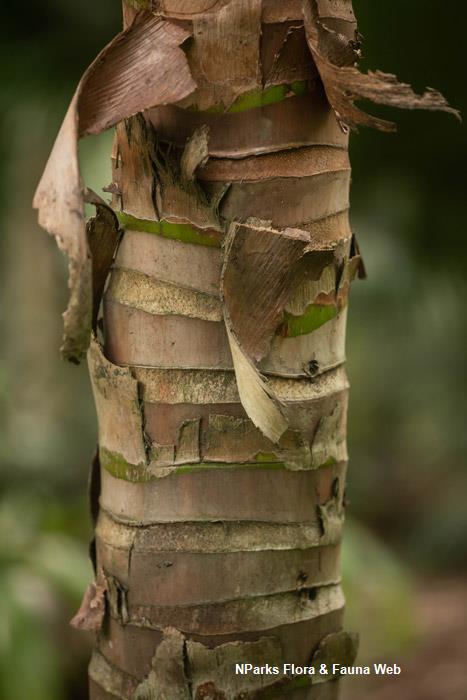_lowres.jpg)
Back
Calyptronoma occidentalis (Sw.) H.E.Moore
| Family Name: | Arecaceae (Palmae) |
| Synonyms: | Calyptrogyne occidentalis (Sw.) M.Gómez, Calyptrogyne swartzii Hook.f., Calyptronoma swartzii Griseb., Elaeis occidentalis Sw., Geonoma swartzii Griseb., Calyptrogyne victorinii León |
| Common Name: | Manac Palm, Long Thatch |
Calyptronoma occidentalis , also known as Manac Palm, is a solitary palm which can reach up to 15 m tall. Found naturally in the swampy forests and marshes of Jamaica, it thrives in moist soils with good drainage.
Name
Classifications and Characteristics
| Plant Division | Angiosperms (Flowering Seed Plants) (Monocotyledon) |
|---|---|
| Plant Growth Form | Palm |
| Lifespan (in Singapore) | Perennial |
| Mode of Nutrition | Autotrophic |
| Maximum Height | 15 m |
Biogeography
| Native Distribution | Jamaica |
|---|---|
| Native Habitat | Terrestrial |
| Preferred Climate Zone | Tropical |
| Local Conservation Status | Non-native |
Description and Ethnobotany
| Growth Form | A solitary, unarmed, palm with ascending to spreading, arching, pinnate (feather-like) fronds, by which the young leaves are red-bronze and turning green with age. |
|---|---|
| Trunk | The trunk is solitary, up to 15 m tall and 30 cm in diameter. It is brown, ringed with old leaf scars. Crownshaft is absent. |
| Foliage | The fronds are feather-like (pinnate), up to 4.3 m long, with about 60 segments. They are red-bronze when young, gradually turning green with age. The leaflets can reach up to 95 cm long and 4.5 cm wide, bearing inconspicuous multicellular trichomes on the underside. The petiole is short and the sheath is non-persistent. |
| Flowers | Inflorescence is borne singly in the axial (the main stalk) of each frond, first erect then later pendulous, having three (very rarely, four) orders of branching; flowers cream, arranged in triads (one female flower flanked by two male flowers) |
| Fruit | Fruit is obovoid (having the form of an inverted egg), up to 15.8 mm long, ripening from green to red to purple-black. Each fruit contains one seed within. Seeds are sphere-like to ellipsoid (oval shape), brown-black and up to 8.6 mm long. |
| Habitat | It is found in swampy forests, marshes and along mountain streams. |
| Cultivation | It prefers partial shade, but can be grown in full sun once it is established. It fancies constantly moist soils with good drainage. It can be propagated by seeds and germinates in 2 to 4 months with bottom heat. |
| Etymology | The genus epithet 'Calyptronoma' is derived from the two Greek words 'calyptron' 'a veil or covering', and 'nomos' 'a cap', in reference to the petals of its flower forming a dehiscent cap. The species epithet 'occidentalis' means 'of or from the west' in Latin, in probable reference to its origins. |
| Ethnobotanical Uses | Others: Traditionally, the fronds are used for thatch, and the stems are used for construction. |
Fauna, Pollination and Dispersal
| Pollination Method(s) | Biotic (Fauna) |
|---|
Plant Care and Propagation
| Light Preference | Semi-Shade |
|---|---|
| Water Preference | Moderate Water |
| Plant Growth Rate | Moderate |
Foliar
| Mature Foliage Colour(s) | Green |
|---|---|
| Foliar Shape(s) | Palm Fronds (Pinnate / Feather) |
| Leaf Area Index (LAI) for Green Plot Ratio | 2.5 (Palm - Solitary) |
Non - Foliar and Storage
| Trunk Type (Palm) | Solitary Habit, Aboveground |
|---|
Floral (Angiosperm)
| Flower Colour(s) | Cream / Off-White |
|---|
Fruit, Seed and Spore
| Mature Fruit Colour(s) | Black |
|---|
Image Repository
Others
| Master ID | 1312 |
|---|---|
| Species ID | 2605 |
| Flora Disclaimer | The information in this website has been compiled from reliable sources, such as reference works on medicinal plants. It is not a substitute for medical advice or treatment and NParks does not purport to provide any medical advice. Readers should always consult his/her physician before using or consuming a plant for medicinal purposes. |

_lowres.jpg)
_lowres.jpg)
